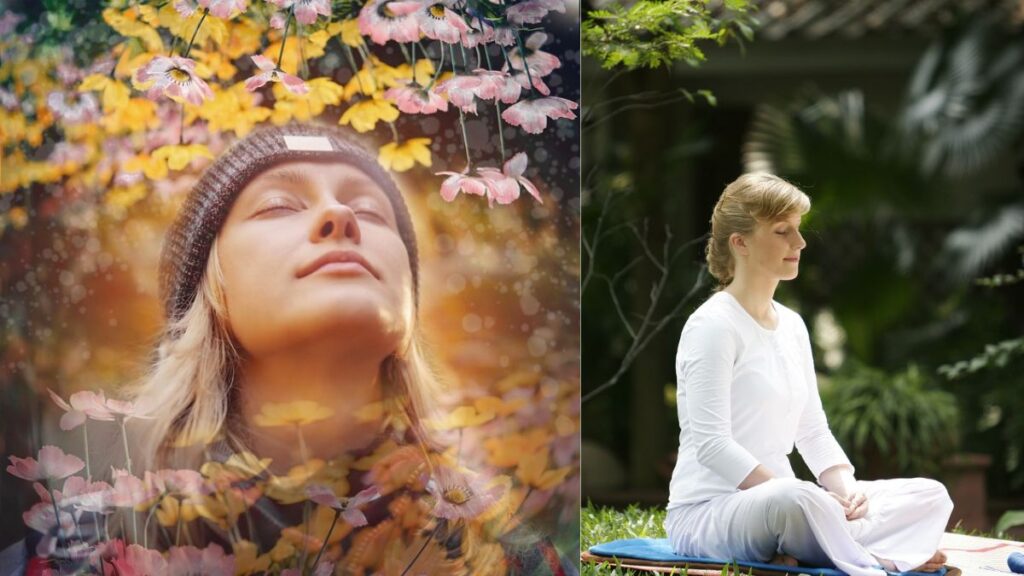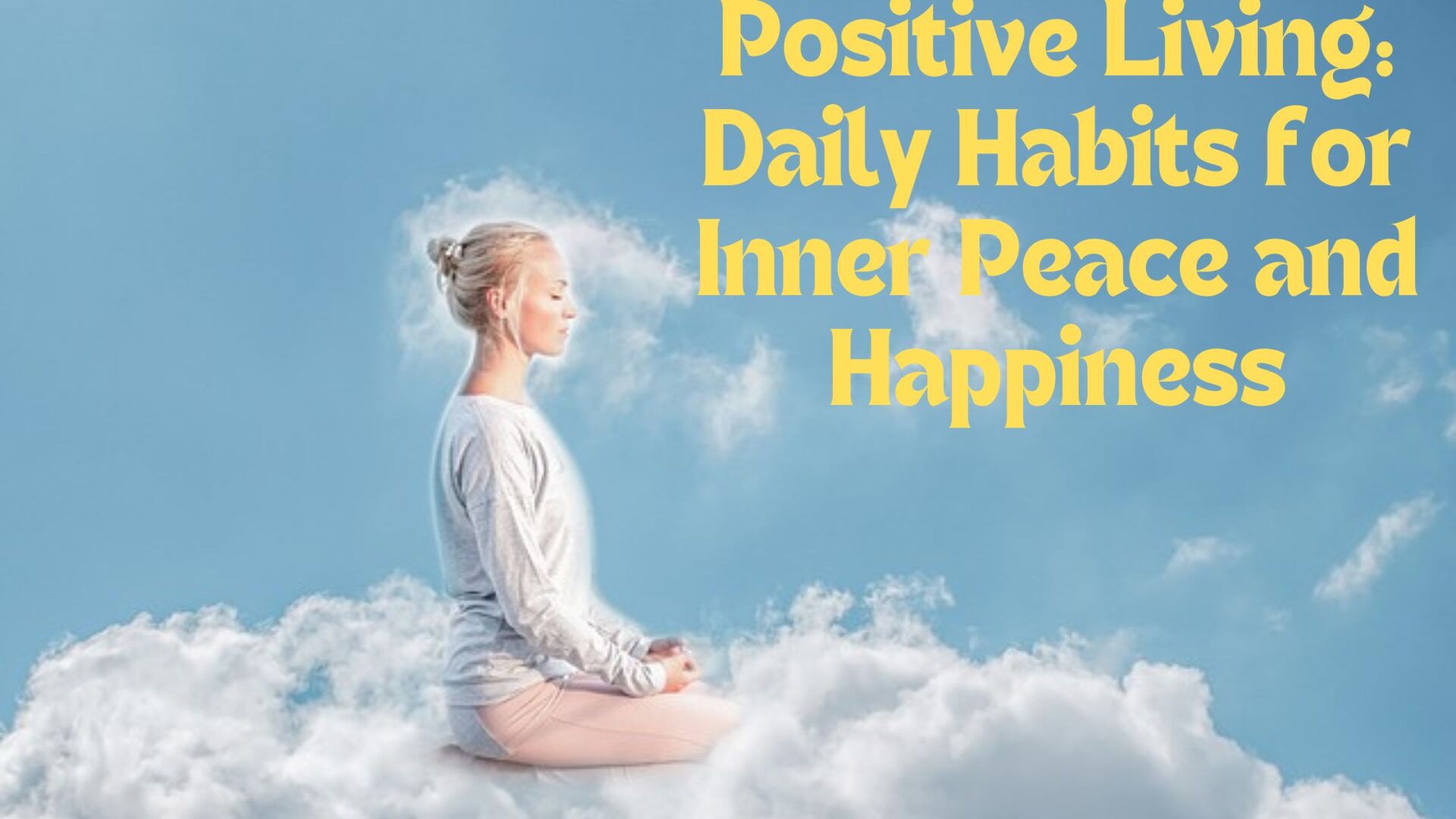Introduction:-
Positive Living: Daily Habits for Inner Peace and Happiness

In a world characterized by constant hustle and bustle, attaining inner peace and happiness can be elusive. However, incorporating specific daily habits into your routine holds the power to revolutionize your sense of well-being and tranquility. This article delves into practical and effective strategies that can help cultivate positivity and foster inner peace within your life.
What are simple ways to achieve happiness and inner peace?
Achieving happiness and inner peace can often be more straightforward than it seems. Here are some simple strategies:
- Practice Gratitude:
- Keep a gratitude journal and write down three things you’re grateful for each day.
- Reflect on positive experiences and appreciate the small joys in life.
- Mindfulness and Meditation:
- Spend a few minutes each day in meditation to focus on your breath and clear your mind.
- Practice mindfulness by staying present and fully engaging in whatever you’re doing.
- Healthy Lifestyle:
- Eat a balanced diet rich in fruits, vegetables, and whole grains.
- Exercise regularly, even if it’s just a short walk each day.
- Get enough sleep and maintain a consistent sleep schedule.
- Build Positive Relationships:
- Spend quality time with family and friends.
- Surround yourself with supportive and positive people.
- Communicate openly and honestly in your relationships.
- Engage in Activities You Enjoy:
- Pursue hobbies and interests that bring you joy.
- Set aside time for activities that make you feel fulfilled and happy.
- Practice Self-Compassion:
- Be kind to yourself and avoid self-criticism.
- Acknowledge your mistakes and learn from them without dwelling on them.
- Simplify Your Life:
- Declutter your living space to create a calm environment.
- Prioritize your tasks and focus on what truly matters.
- Avoid overcommitting and learn to say no.
- Connect with Nature:
- Spend time outdoors, whether it’s in a park, garden, or any natural setting.
- Appreciate the beauty of nature and take moments to relax outside.
- Set Realistic Goals:
- Set achievable and meaningful goals for yourself.
- Break down larger goals into smaller, manageable steps.
- Give Back:
- Volunteer your time or donate to causes you care about.
- Acts of kindness and helping others can boost your own sense of happiness and fulfillment.
Incorporating these practices into your daily routine can gradually lead to greater happiness and inner peace. It’s important to find what works best for you and be patient with yourself as you make these changes.
How can limiting social media use contribute to inner peace?
Unlocking Inner Peace Through Mindful Social Media Consumption:

Limiting social media use can significantly contribute to inner peace by fostering a healthier relationship with technology and ourselves. Here’s how:
- Reduced Stress and Anxiety:
- By minimizing exposure to curated portrayals of others’ lives, you can combat feelings of inadequacy and anxiety. This promotes a more positive self-image.
- Improved Focus and Productivity:
- Reducing time on social media can eliminate distractions, allowing for better concentration, increased productivity, and a sense of accomplishment, all of which contribute to inner peace.
- Enhanced Sleep Quality:
- Limiting social media use, especially before bedtime, can improve sleep patterns. Better sleep is essential for mental and emotional well-being.
- Strengthened Real-Life Relationships:
- Spending less time on social media allows for more meaningful interactions with family and friends. Face-to-face communication can deepen emotional connections and strengthen relationships.
- Decreased Exposure to Negativity:
- Social media can expose users to negative news, cyberbullying, and toxic behavior. Reducing usage minimizes exposure to such content, fostering a more positive mental state.
- Increased Mindfulness and Presence:
- Limiting social media use encourages being present in the moment. Practicing mindfulness can reduce stress and enhance overall happiness.
- More Time for Self-Care:
- With less time spent on social media, you can prioritize activities that promote well-being, such as exercise, hobbies, reading, and relaxation.
- Boosted Self-Esteem:
- Without constant comparisons to others, individuals can develop a more positive self-view based on their own achievements and qualities rather than perceived social media standards.
- Improved Emotional Regulation:
- Limiting social media use can help maintain a more stable emotional state, reducing the impact of emotional triggers often found online.
- Encouragement for Personal Growth:
- With more time away from social media, individuals can focus on personal development, learning new skills, and pursuing interests that contribute to long-term satisfaction and peace.
By consciously reducing social media consumption, you can create a life that fosters mental health and a deeper sense of inner peace.
How can I develop a consistent routine for inner peace?
To achieve inner peace, cultivating a consistent routine that promotes mental, emotional, and physical well-being is essential. Here’s a step-by-step guide to help you create and maintain such a routine:

- Set Clear Intentions:
- Identify your goals for inner peace. This clarity will guide your routine and keep you motivated.
- Mindful Mornings:
- Engage in 5-10 minutes of meditation each morning to focus on your breath and set a positive tone for the day.
- Practice gratitude by writing down three things you’re grateful for to cultivate a positive mindset.
- Prioritize Physical Activity:
- Engage in physical activities like yoga, walking, or any exercise you enjoy. Aim for at least 30 minutes daily to release endorphins and reduce stress.
- Create a Balanced Schedule:
- Plan your day with a mix of work, rest, and leisure.
- Prioritize high-priority tasks first to avoid feeling overwhelmed.
- Practice Mindfulness Throughout the Day:
- Take short breaks to check in with yourself, stretch, breathe deeply, or take a quick walk.
- Engage fully in whatever you’re doing to stay present.
- Nourish Your Body:
- Eat a balanced diet rich in whole foods and stay hydrated.
- Maintain regular meal times to stabilize your energy levels and mood.
- Limit Screen Time:
- Set specific times to check emails and social media.
- Avoid screens at least an hour before bed to improve sleep quality.
- Be selective about what you read or watch, choosing content that uplifts and informs.
- Cultivate Positive Relationships:
- Spend quality time with supportive friends and family.
- Practice active listening and open communication to strengthen your relationships.
- Calm Evenings:
- Spend a few minutes reflecting on your day, writing down accomplishments, and things you’re grateful for.
- Develop a bedtime routine that helps you unwind, such as reading, stretching, or taking a warm bath.
- Seek Continuous Growth:
- Dedicate time to personal development through reading, learning new skills, or pursuing hobbies.
- Be kind to yourself, acknowledging your efforts, and progress.
- Regular Review and Adjustment:
- Periodically review your routine, assessing what’s working and what’s not.
- Make adjustments as needed and set realistic goals to avoid adding stress.
Consistency is key, so be patient and gentle with yourself as you establish new habits. By integrating these practices into your daily routine, you can create a sustainable path toward inner peace.
Conclusion
Embark on a continuous journey to cultivate inner peace and positivity. Integrate these daily habits into your routine to create a solid foundation for lasting happiness and tranquility. Remember, even small adjustments can lead to significant improvements in your overall well-being. Commence this positive living journey today and embrace the transformative power it brings.
References
- Mindfulness Meditation:
- Kabat-Zinn, J. (1994). Wherever You Go, There You Are: Mindfulness Meditation in Everyday Life. Hyperion.
- Mindful. (2020). “The Benefits of Mindfulness: Practices for Improving Well-Being.” Retrieved from Mindful.org.
- Gratitude:
- Emmons, R. A. (2007). Thanks!: How the New Science of Gratitude Can Make You Happier. Houghton Mifflin Harcourt.
- Harvard Health Publishing. (2021). “Giving Thanks Can Make You Happier.” Retrieved from Harvard Health.
- Exercise and Mental Health:
- Ratey, J. J. (2008). Spark: The Revolutionary New Science of Exercise and the Brain. Little, Brown.
- Mayo Clinic Staff. (2021). “Exercise: 7 Benefits of Regular Physical Activity.” Retrieved from Mayo Clinic.
- Balanced Diet:
- Willett, W. C., & Skerrett, P. J. (2005). Eat, Drink, and Be Healthy: The Harvard Medical School Guide to Healthy Eating. Free Press.
- Harvard T.H. Chan School of Public Health. (2021). “The Nutrition Source: Healthy Eating Plate.” Retrieved from Harvard T.H. Chan.
- Hydration:
- Popkin, B. M., D’Anci, K. E., & Rosenberg, I. H. (2010). “Water, Hydration, and Health.” Nutrition Reviews, 68(8), 439-458.
- Centers for Disease Control and Prevention (CDC). (2020). “Water & Nutrition.” Retrieved from CDC.
